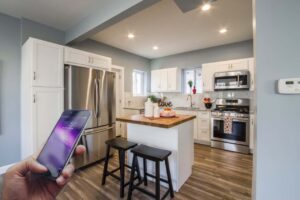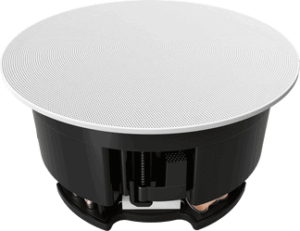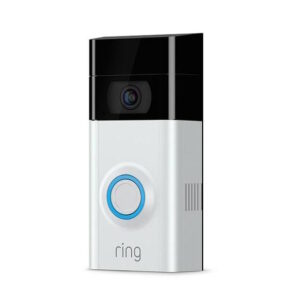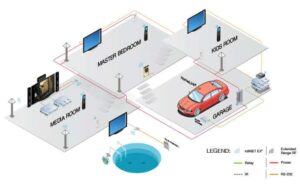May 30, 2019 / by HomeSquare’s in-house designer, Katie Canfield
Whether you want to add some technology investments into your home or you’re prepping your home for sale, here are 4 ways to make your house a smart home.

1. Invest While Your Walls Are Open
If you’re already doing some renovations where you’re taking down the drywall, consider your options while walls are open.
- You can prewire for speakers or motorized shades without actual investing in those features.
- Wireless speaker options like Sonos have built-in speaker systems for an extra sleek look but with all of the benefits and software options of the system.
- For Sellers: Make sure you provide this information to future buyers. For example: “Newly renovated living room, pre-hardwired for sound system.” Even if the buyer isn’t interested, it keeps options open for the future.
2. Sticking to the Bare Minimum
If you’re feeling a bit in over your head (and trust me I am by no means a techie) I would say to stick to the bare minimum “essentials” of today’s smart home. A video door bell or other means of surveillance, a smart lock, and possibly a smart thermostat.
- Video Doorbell: Nowadays many homes are getting deliveries almost everyday and package theft is on the rise. Video doorbell options have seen a huge increase. Keep an eye on deliveries or who’s ringing your doorbell while you’re away. You can also set a motion sensor that will alert you if someone is at your door. The Ring Video Doorbell is probably the most popular brand. But shop around to see what has the best aesthetic and software features for you.
- Smart Lock: You can lock and unlock remotely from your phone and provide digital keys for any expected visitors. I’ve even seen a deadbolt that automatically locks after a determined interval of time.
- Smart Thermostat: Systems such as Nest can be integrated throughout the home and all for adjusting the temperature remotely. If you’re traveling and forgot to adjust the thermostat, you can do it from your phone. Nest also has carbon monoxide and smoke detectors, as well as video doorbells and surveillance, which can allow you to keep everything on one system for ease of use.
- For Sellers: Your millennial buyers will thank you, as will the “empty nester” buyers that may have multiple properties. Providing smart lock and video door bell technology is not only providing them with the new “it thing” you’re also giving them peace of mind.
3. Keep it Scalable
If you’re making a large investment into your home – either building from the ground up, or doing a major renovation, keep resale, and your own long term growth in mind!
- Make. It. Scalable. This means leaving room to grow with the technology, and keep everything on one easy to use system. Having separate apps for motorized window shades, security, and thermostats isn’t a sustainable model. You’ll be nothing but confused and frustrated.
- Find a system that works for the entire home. Lutron and Crestron are probably the two most well known companies for providing entire smart home technology. If you’d like an entire smart home, I highly recommend making an appointment to tour a showroom. You should touch and understand all of the features. You can also pair down to just the features that you will actually use everyday. This will save you $$$ on technology you won’t use. I recently took a tour of the Crestron showroom in NYC and was astonished with how far the technology has come and how easy it is to use or upgrade.
- The best part about these systems is they are scalable. If there’s proper planning and hardwiring done on the front end, you can continue to grow and add features as needed. Perhaps you’re just looking to have controlled lighting in your home and be able to set “scenes” at the touch of a button. (A lighting “scene” creates an atmosphere with lighting as opposed to turning on a specific fixture. It may turn on several different fixtures to a predetermined dimmer setting, etc). Or perhaps motorized window treatments will be something that’ll interest you later on. By prewiring ahead of time, you have the option to add additional features when you’re ready. And it can be easily added to your existing software system without adding another remote or app. This means as technology changes and develops you won’t be stuck with “last year’s model”.
4. Check Compatibility and Don’t Force People to Choose Alexa or Google
Here’s a tip that’s targeted just For Sellers: when it comes to smart home technology, beware of selecting a product that ONLY works with Google Assistant or Amazon’s Alexa.
- There are many people who are wary about bringing Alexa into their home, for security reasons as well as potential hacking. If you select a product that can operate independently on its own, but also works with Alexa or Google or both, then I say ok.
- Having an entire “smart home” that is Alexa dependent may be hard to sell, especially to a prospective buyer that is not keen on Alexa technology. Not to mention the sound recognition and linguistic capabilities on these systems still have a long way to go.
- If you’re going to deck your house to the nines in technology, I certainly think it’s worth the investment to look at a system like Crestron.
[divider style=”single” border=”small”]

Katie Canfield is the founder and principal designer at Studio KC. Studio KC got its humble start in 2015 when Katie was just 23 years old. While she was freelancing with other interior designers in the NY and CT area she also became a go-to designer for local contractors and trades that needed a designer’s help for their clients whether it be for custom cabinetry drawings or plans for a gut renovation on an entire home.
Katie Canfield’s design aesthetic is eclectic and flexible. She delights in the marriage between old and new- keeping spaces approachable but still matching each client’s unique aesthetic and family narrative. Her passion for design keeps her motivated and constantly on the hunt for new trends and materials. Her broad experience includes an art history background, study at the Accademia Italiana in Florence, a stint with the renowned Manhattan firm Amanda Nisbet Design, as well as collaborations with builders and designers across the tri-state area. She’s seen it all: from gutting prewar Manhattan apartments to new construction in the ‘burbs.








